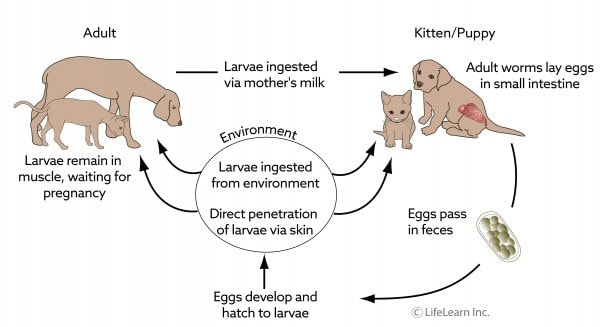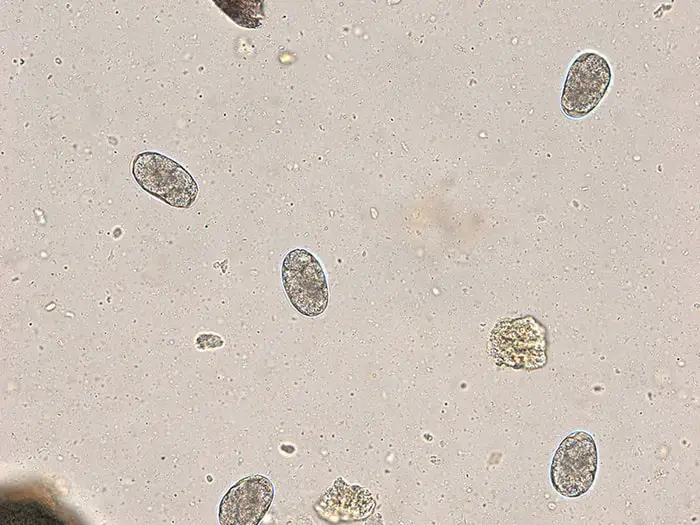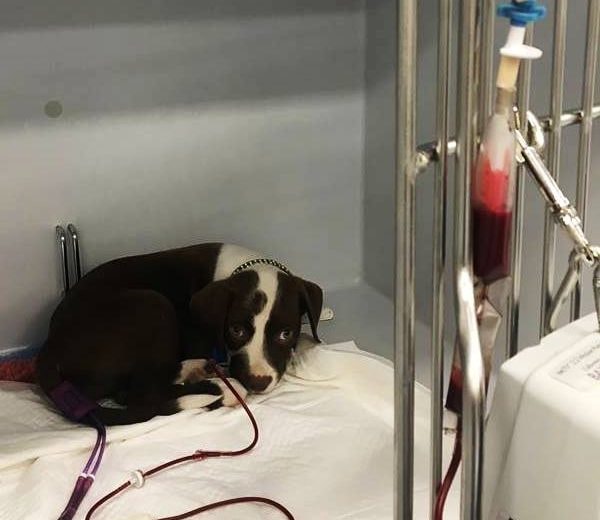Hookworm in dogs are intestinal parasites, and adult worms attach the mucosa of the small intestine, usually in the jejunum, but occasionally from the pylorus to the colon. These parasitic infections are common in puppies and are found in other carnivores as well as in dogs. Ancylostoma caninum, Ancylostoma braziliense, and Uncinaria stenocephala are the causative worms of the hookworm disease in dogs. Ancylostoma caninum is the essential hookworm of dogs and is associated with blood loss and hemorrhagic enteritis.
Transmission of Hookworm in Dogs
Hookworm infection is one of the common dog problems that you need to take adequate measures early. The knowledge of transmission will help you to take necessary preventive measures. Usually, all age groups are susceptible, but dogs aged less than one year old are more vulnerable. Most of the dog breeds are susceptible to canine hookworm infection. Hookworm larvae mainly transmitted in four ways that are:
- Skin penetration by the larvae.
- Oral with feed.
- Transmammary from mother to puppies.
- Transplacental.

Clinical Signs of the Hookworms in Dogs
The disease is frequent in summer and especially in animals that are confined on a relatively small area of moist ground. The severity of clinical signs depends on some factors like:
- The age and nutritional status of the animal (young animals are more severely affected).
- The number of parasites present.
- The host resistance developed by previous infections.
- Enteritis and debilitating hemorrhagic diarrhea, shock, and death in severe cases.
- A single parasite may remove as much as 0.8 ml of blood per day and produce hypochromic microcytic anemia.
- Visible mucous membranes of infected dogs often are pale.
- Diarrhea, weakness, vomiting, dehydration, weak growth, and anemia are common in puppies with A. caninum infection.
- The infection can cause rapid and fatal anemia or a more chronic iron deficiency anemia.
- Itching of the skin and areas of dermatitis caused by penetration of the skin by the larvae of the worm.

How Could Diagnose Hookworm in Dogs?
A presumptive diagnosis of hookworm infection can be made on:
- History of infection in other dogs.
- Clinical examination of your dog due to anemia and weakness.
- Hookworm infection may be confirmed by demonstration of the eggs in the feces by microscopic examination.
- The prenatal disease can be diagnosed based on anemia, to develop before eggs appear in the feces.

Treatment of Hookworm in Dogs
There are various types of anthelmintics drugs which will eliminate the hookworm disease.
- Disophenol, pyrantel pamoate is very useful for the condition.
- Pyrantel pamoate has been suggested as the treatment of choice for anemic puppies as it acts rapidly and is comparatively safe in debilitated animals.
- Pale puppies may require blood transfusion and supportive care.
- Hookworm disease can be prevented by treating puppies at 2, 4, 6, and 8 weeks of age.
- Monthly administration of milbemycin or ivermectin plus pyrantel pamoate is approved for the prevention or control of hookworm in dogs.
- Any modern broad-spectrum anthelmintic may be used for treatment.
- Severely infected puppies with black, tarry stools and pale mucous membranes should be given a blood transfusion until the oral mucosa regains its color.

- Hematopoietic agents like iron, liver extract, and vitamin B12, are beneficial.
- If an animal is known to have, reduced tolerance for the anthelmintic, lipotropic agents like choline and methionine should be given with IV infusions of dextrose before the anthelmintic is administered.
Prevention and control Canine Hookworm
- Control is also dependent on adequate kennel hygiene, with fecal materials being collected and runs disinfected.
- The pre-infective stages are not resistant to desiccation, so that ground and pens on which susceptible animals are kept should be as dry as possible, and feces should be removed at short intervals.
- The floor of kennels could be treated with common salt or sodium borate, which helps to kill the larvae.

Concluding Remarks on Hookworms in Dogs
Hookworm infection is a widespread parasitic disease of pet dogs. As a dog owner, you must have a basic idea about the most prevalent parasitic dog disease. I have highlighted the basic features of hookworm in dogs for your easy understanding. If you take regular care of your dogs, you can save your dog from this deadly disease.